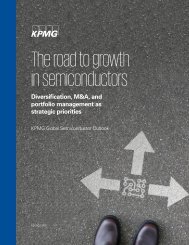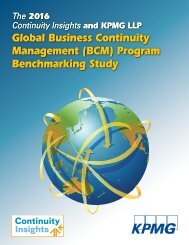Revenue for Telecoms
2cdncba
2cdncba
You also want an ePaper? Increase the reach of your titles
YUMPU automatically turns print PDFs into web optimized ePapers that Google loves.
140 | <strong>Revenue</strong> <strong>for</strong> <strong>Telecoms</strong> – Issues In-Depth<br />
| 7 Contract costs<br />
Example 57 – Commission paid on renewals after the initial contract<br />
is obtained<br />
Continuing Example 54 (see 7.1). Fact pattern is repeated here <strong>for</strong> convenience.<br />
Telco A pays its sales employees a commission of 30 <strong>for</strong> each new two-year<br />
wireless contract entered into with a customer. Telco A also pays 10 to sales<br />
employees each time a customer renews a contract <strong>for</strong> an additional two years.<br />
Telco A previously concluded that both commissions qualify as a cost to obtain a<br />
contract and are capitalized when they are incurred.<br />
Based on historical experience and customer analysis, Telco A expects the<br />
customer to renew <strong>for</strong> an additional two years <strong>for</strong> a total of four years. Telco A<br />
further observes that the 10 renewal commission is not commensurate with the<br />
30 paid at the inception of the contract.<br />
Telco A concludes that the first commission relates to a longer period than the<br />
initial two-year contract term. The commission should there<strong>for</strong>e be amortized over<br />
four years – i.e. on a systematic basis consistent with the pattern of satisfaction<br />
of the per<strong>for</strong>mance obligation, and including the specifically anticipated renewal<br />
period. The renewal commission, however, is amortized over two years, being<br />
the period to which the commission relates. In this fact pattern, the amortization<br />
expense would there<strong>for</strong>e be higher during the renewal period than during the<br />
initial contract period.<br />
Observations<br />
Amortization period may need to include anticipated contracts<br />
Under the new standard, a capitalized contract cost asset is amortized based on the<br />
transfer of goods or services to which the asset relates. In making this determination,<br />
the new standard notes that those goods or services could be provided under an<br />
anticipated contract that the telecom entity can specifically identify.<br />
The new standard does not prescribe how a telecom entity should determine<br />
whether one or more anticipated contracts are specifically identifiable, so practice<br />
is likely to develop over time. Relevant factors to consider may include the<br />
telecom entity’s history with that customer class, and predictive evidence derived<br />
from substantially similar contracts. In addition, a telecom entity may consider<br />
the available in<strong>for</strong>mation about the market <strong>for</strong> its goods or services beyond the<br />
initial contract term – e.g. whether it expects the service still to be in demand<br />
when renewal would otherwise be anticipated. Judgment will be involved in<br />
determining the amortization period of contract cost assets, but telecom entities<br />
should apply consistent estimates and judgments across similar contracts, based<br />
on relevant experience and other objective evidence.<br />
Home<br />
© 2016 KPMG LLP, a Delaware limited liability partnership and the US member firm of the KPMG network of<br />
independent member firms affiliated with KPMG International Cooperative, a Swiss entity. All rights reserved.<br />
© 2016 KPMG IFRG Limited, a UK company, limited by guarantee. All rights reserved.







